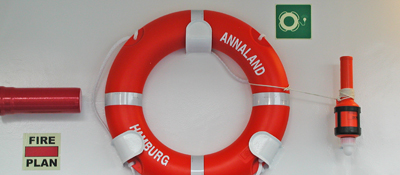Referat Nautik
Brandstwiete 1
20457 Hamburg

Peer Lange
Phone: +49 40 36137-319
Fax: +49 40 36137-204
Mobile: +49 171 882 70 68
Mail: nautik@bg-verkehr.de
Life-saving appliances
- Innovation in life-saving appliances
- Problematic recovery of persons fallen over board
- Our compilation of videos
- Mandatory requirement for on-board plans and procedures
- Approved servicing stations
- Annual service for liferafts
- Development of practicable recovery equipment
The German flag spearheads innovation in life-saving appliances
Good and safe life-saving appliances are indispensable. For life-saving appliances on seagoing ships engaged on international voyages mandatory requirements have been established worldwide by the International Maritime Organization (IMO). A vital factor is periodic testing and maintenance by competent service providers.
The German flag has always spearheaded innovation in life-saving appliances. Just one example is the freefall lifeboat, which was developed in Germany and is now widely used all over the world. Also the amendment of the SOLAS convention which requires ships to be fitted with equipment for recovery of persons from the water results from a German initiative, co-ordinated by the ship safety division of the BG-Verkehr.
Problematic recovery of persons fallen over board
Even though all seafarers are aware of the danger, they remain vulnerable to be washed overboard by large waves. The question how to get them back on board becomes even more pressing when, in case of a major maritime accident, large numbers of persons may have to be recovered from the water.
Large ships may have a freeboard in excess of 10 m. Such a height can only be overcome if suitable equipment is available on board. A rescue boat as prescribed for larger ships can only be operated in moderate sea conditions, as its crew members would otherwise risk their own lives.
During a recovery operation from the water it is important to keep the person in a horizontal position. Otherwise a hypothermic casualty may suffer a fatal cardiac arrest due to a decrease in blood pressure after the recovery from the water. This happens frequently in recovery operations by helicopter.
Innovative life-saving appliances attempt to provide solutions for these vital challenges of personal rescue.
Our compilation of videos on recovery of persons from the water
The ship safety division of the BG Verkehr offers several videos for download, which show recovery systems (devices) developed in France, Norway and Germany. Another video, showing „medical first aid in case of hypothermia“, may be particularly useful for training and education.
- "Rescue Star im Einsatz" (deployment of the Rescue Star; 03:46 min.)
- "Person über Bord! Rettung auf hoher See" (Person over board! Recovery at sea; 16:34 min.)
- "Medizinische Erstmaßnahmen bei Unterkühlung" (medical first aid in case of hypothermia; 10:59 min.)
- "Rettungs-Systeme" (recovery systems; 10:51 min.)
- "Sealift Rettungssystem" (Sealift recovery systems; 5:21 min.)
- "Squid Rettungssystem" (Squid recovery system; 2:44 min.)
- "Janssen Eindocksystem" (Janssen docking system; 2:25 min.)

Mandatory requirement for on-board plans and procedures for recovery of persons from the water
The ship safety division of the BG-Verkehr has strongly advocated the introduction of appropriate recovery systems on board of ships. This initiative at the International Maritime Organization (IMO) was supported by Australia, France, the United Kingdom, Iceland, Sweden and the International Maritime Rescue Federation (IMRE). Their efforts were finally rewarded: Shipowners are obliged to implement plans and procedures for recovery of persons from the water on board of their ships and fit new equipment, if required. The relevant regulation 17-1 of SOLAS chapter III applies to all ships regardless of size and trading area, except for special ships, ships of traditional build, recreational craft and warships.
For further information please refer to SOLAS regulation III/17-1, adopted with resolution MSC.338(91), and to the circular MSC.1/Circ.1447.
The ship safety division of the BG Verkehr supports owners of ships under the German flag in the assessment and selection of existing and novel recovery systems.
Approved servicing stations for lifeboats and launching appliances
Classification societies (recognized organizations, ROs) are responsible for the approval of servicing stations for lifeboats and rescue boats, launching appliance and release mechanism. The legal basis for this is IMO Resolution MSC.402(96).
The table below lists the approved service stations reported by the classification societies.
|
Serviceanbieter |
Zulassung durch eine anerkannte Organisation (Klasse) |
Weitere Infos |
|---|---|---|
|
Several |
DNV – Please use the 'Approval Finder' Note on DNV Approval Finder:
Approvals covering more than one servicing station will be listed once for each servicing station. By clicking on a certificate, it will be downloaded. The link given above leads to the service portal of DNV with the currently valid certificates made publicly accessible (contains all relevant information, but is not signed/stamped) |
Annual service for liferafts
Please find here a list of service stations for liferafts in Germany.
Development of practicable recovery equipment
The ship safety division of the BG Verkehr (previously: See-Berufsgenossenschaft) has since 2006 co-ordinated the German efforts for the development of systems for recovery of persons from the water by establishing a working group attended by, amongst others:
- Shipping company NSB,
- Project SARRAH,
- German federal police (Bundespolizei),
- German shipowners’ association (Verband Deutscher Reeder),
- German federal bureau of maritime casualty investigation (Bundesstelle für Seeunfalluntersuchung),
- Germanischer Lloyd,
- Seafarers’ school of Schleswig-Holstein,
- The German navy,
- Hochschule für angewandte Wissenschaft und Kunst (HAWK), Hildesheim (Prof. Michael Schwindt).
The ship safety division of the BG Verkehr has co-ordinated these developments, arranged tests and trials and produced several videos.

